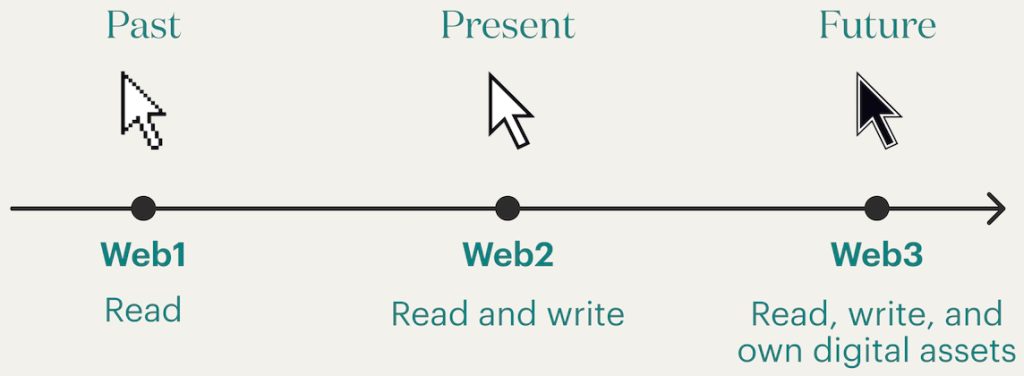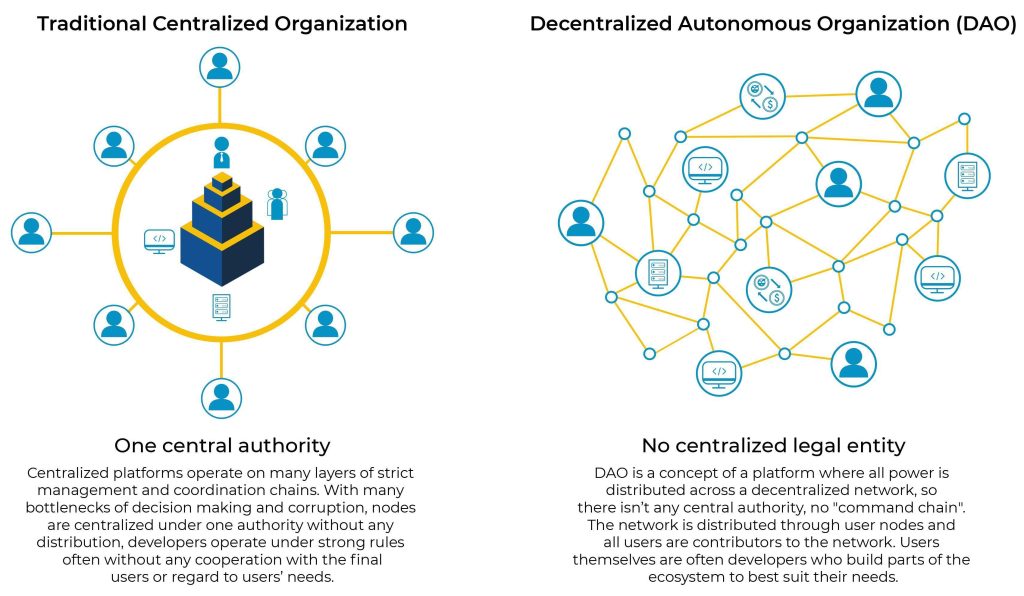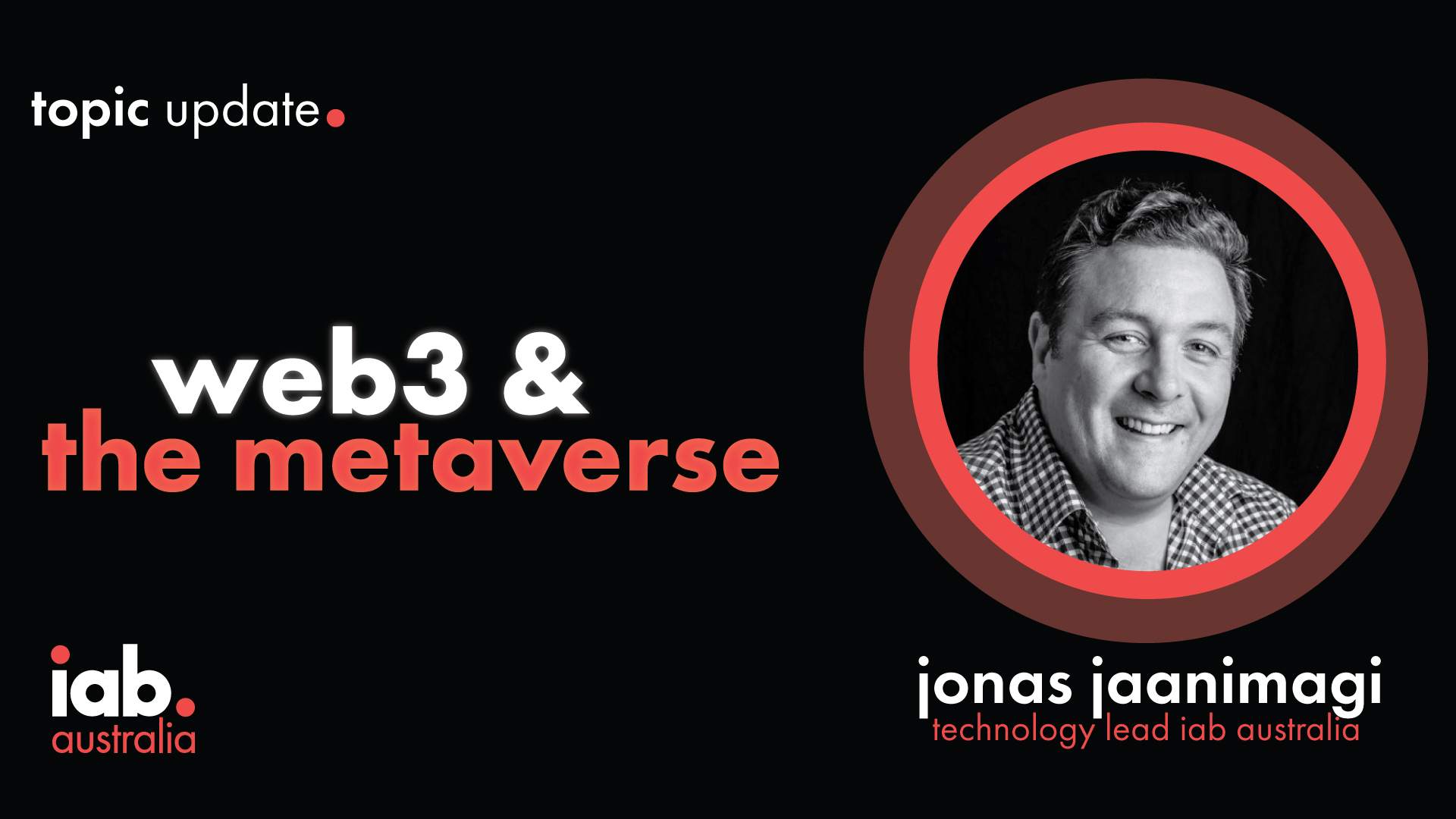The IAB Australia Gaming Working Group is keen to look at Web3 as a topic and what opportunities for marketers can, and could, exist within enabled opportunities such as the Metaverse.
As a starting point we’ve tried to provide some initial definitions on Web1, Web2 & Web3 generally in this introductory article – as well as some initial pointers on what the Metaverse is. Separately we’ve also asked some of the members of the Gaming Working Group to collaboratively add their thoughts on what the potential implications and opportunities are for marketers, including some meaningful examples, in a separate Q&A article.
To read the related Q&A on what all of this means for marketing simply click here
As a starting point, let’s look at some definitions of Web1, Web2 & Web3. Thereafter we’ll look more closely at web3 and then will try and provide a simple explainer of the Metaverse. More info on this topic can be found within the linked Q&A article.
Web1 (read)
The early version of the internet consisted of static ‘read-only’ web pages hosted on web servers run by internet service providers or free web hosting services. Pages were mainly designed to allow information to be more freely consumed, were connected via hyperlinks and discoverable via directories (such as Lycos, Yahoo! and Ask Jeeves) most of which were gradually evolving into basic search engines. However, these experiences were still without many of the additional visuals, controls and interactive capabilities which we take for granted today.
Consumers were more passive as a result – and any advertising on these pages generally surrounded the content in the form of simple .jpg files and from the late 90’s active.gif files. Any tracking of the performance of ads was initially managed by publishers, and then increasingly via variables in html through simple <img> tags and the <a> tag with the href attribute.
Web2 (read & write)
From the early 2000s the internet experience evolved from a ‘read-only’ experience to one with the capability to both ‘read’ and ‘write’ – as consumers could now enter information into web fields and communicate directly with hosting servers in real time. As connection speeds improved people could now not only access more information more quickly, but also by sending information back to servers could get more targeted information and other user generated results. Soon thereafter a swathe of web services took off as providers could now leverage this interactivity to dramatically transform software services from the static web into social connectivity and user-generated content.
As a result, consumers could now write content to the web and interact with each other much more meaningfully. Rather than maintaining one’s own server to host websites, companies started to provide this for free and in exchange, build massive data silos of behaviours and actions allowing these platforms to construct enormous social graphs. Individual users were now the product, with transactional services and marketing driving enormous engagement through increased innovation, product development and exceptional user experiences. The discovery experience dramatically improved through indexing capabilities and was also becoming increasingly centralised and dominated by one platform provider (Google) – commercially underpinned by advertising.
Digital advertising could now be hugely enriched by these data assets with much improved capabilities in pan-device targeting, tracking and measurement (mainly through 3rd party cookies). Rich media ad units, video and targeted native ads prevailed and were initially delivered more intrusively and interruptedly – practices which have more recently become much improved in terms of consumer experiences.
Web3 (read, write & own / execute)
The concept of Web3 is a response to the centralised nature of Web2 and is a dramatic shift from the era of consumer data collection to a decentralised structure where people have full control over their data. It enables a future where distributed users and machines can collaboratively read, write and interact with data across peer-to-peer networks, giving consumers full control of how their data is being used, transmitted, and stored – without the need of the large third parties that have underpinned Web2.
This new iteration of the internet looks to be more autonomous, intelligent, and open. Largely built on new layers of technological innovation, with decentralisation as a core feature to enable everyone to use the internet as they see fit without having to rely upon large, centralised entities. The vision is to drive the distribution flow of value back to creators, users, and developers. Ownership can be represented by digital tokens or cryptocurrencies, enabled through blockchains, and should one hold enough tokens within a particular network, you can have more say over the operation or governance of that network.
We’ll look more closely at some of the core features of Web3 below…

What are the Core Features of Web3?
I’ve collated a number of core features (some established and others emerging) into four areas which I feel will essentially be required to underpin the core capabilities and promises of Web3.
-
- Semantic Web & AI: The evolution of the Web will involve the Semantic Web, which improves the abilities of web technologies to generate, share and connect content through search and analysis by understanding the meaning of words rather than by keywords or numbers. By combining the resulting semantic metadata capabilities with natural language processing, computers can understand information on a human-like level to provide faster and more relevant results. In doing so, they become more intelligent and better satisfy the needs of all users.
- Decentralisation & Blockchain: Decentralised data networks store data within a peer-to-peer interconnection. This allows users to maintain ownership over their data and digital assets and are able to log in securely over the internet without being tracked. Through blockchain technology, user data is protected and encrypted via decentralised transactional ledgers across peer-to-peer networks. Using this technology, participants can confirm transactions without a need for a central clearing authority. This approach generates true trust without the need for large centralised companies controlling and leveraging consumer personal data for commercial gains. This enables some examples of emerging applications such as:
- Semantic Web & AI: The evolution of the Web will involve the Semantic Web, which improves the abilities of web technologies to generate, share and connect content through search and analysis by understanding the meaning of words rather than by keywords or numbers. By combining the resulting semantic metadata capabilities with natural language processing, computers can understand information on a human-like level to provide faster and more relevant results. In doing so, they become more intelligent and better satisfy the needs of all users.
Decentralised autonomous organisations (DAO) – are entities that can be managed through rules encoded as computer programs that are transparent, controlled by participating members and not influenced by any on central entity.
Decentralised applications (dApps) – are applications that are built on top of blockchain and make use of smart contracts to enable service delivery in a programmatic approach that is logged in an immutable ledger.
Decentralised finance (DeFi) – leverages blockchain as the basis for enabling financial services, outside of the confines of a traditional centralised banking infrastructure.
Nonfungible tokens (NFTs) – are tokens stored in a blockchain with a cryptographic hash, making the token unit entirely unique.
- 3D Graphics & Edge Computing: Three-dimensional design is used extensively in websites and services in Web 3.0. Museum guides, computer games, eCommerce, geo-spatial contexts and more are all common examples of this. These immersive experiences will rely on advancements in edge computing, which optimises internet devices and web applications by bringing computing closer to the source of the data. This reduces the need for long distance communications between clients and servers, reducing latency and bandwidth usage for apps and data processed at the network edge on devices such as mobile phones, laptops, appliances, sensors and even smart cars.
- Connectivity & Ubiquitousness: Information can be more connected thanks to semantic metadata and the dramatic improvements in connectivity through 5G. As a result, the user experience evolves into a new level of connectivity that leverages all available information. Internet content and services can be accessed anywhere at any time via any number of devices, rather than exclusively via computers and smartphones. Web 2.0 is already ubiquitous in so many many ways, but the growth of IoT devices will transform this to new levels.

Web2 enabled centralisation has been dominant for some time now and Web3 in some ways is a return to the early open-sourced philosophy of Web1 as a way to build internet services. Technology can replace all forms of traditional governance as no-one has to know or trust anyone else to actively participate. For instance, currently network governance requires large unaccountable groups of employees at large platforms leveraging algorithms in order to decide how information gets ranked and filtered, which users get promoted and which get banned, and other governance decisions.
However, through structures such as cryptonetworks, these decisions are made entirely by the community, using open and transparent mechanisms. Democratic systems are not perfect, but are a lot better than the alternatives and are proving a powerful way to develop community-owned networks and enable genuinely level playing fields for 3rd-party developers, creators, and businesses to read, write, execute and also own (and benefit) from their efforts.
What is the Metaverse and how does it relate to Web3?
The Metaverse, enabled by Web3, will look to build upon the possibilities for human experiences on the internet and iteratively and dramatically transform it by fundamentally altering the role of computers and the internet in our lives. It’s not a new concept per se, for example Second Life was created by Linden Labs back in 2003 but the capabilities of Web3 are now enabling something very different in the future. The best definition I’ve personally seen for the Metaverse comes from Mathew Ball, the author of ‘The Metaverse, And How it Will Revolutionize Everything‘ who defines it as being:
“An interoperable network of real-time rendered 3D virtual worlds which can be experienced synchronously and persistently by an effectively unlimited number of users with an individual sense of presence, and with continuity of data, such as identity, history, entitlements, objects, communications, and payments.”
There is currently the concept of both ‘closed’ and ‘open’ version of the Metaverse. Examples of closed includes the experiences currently available through centralised platforms built by companies such as Meta (Horizon), Epic Games (Fortnite) and Roblox.
The true promise of the Metaverse is for users to openly and seamlessly traverse all of these environments individually and without being constricted by virtual experiences owned and managed by large centralised entities. By enabling true interconnection and interoperability across a series of different platforms, worlds, sites, stores and experiences – users could move seamlessly from Fortnite to Roblox to Oculus, bringing all of their data, skins, NFTs, and digital currency with them as they go.
To keep across all the latest news on Web3, the Metaverse and more we recommend visiting Pedestrian Group’s recently launched dedicated site – The Chainsaw
Also, for more insights from some members of our Gaming Working Group into the Metaverse and its potential application for marketing purposes simply click here
